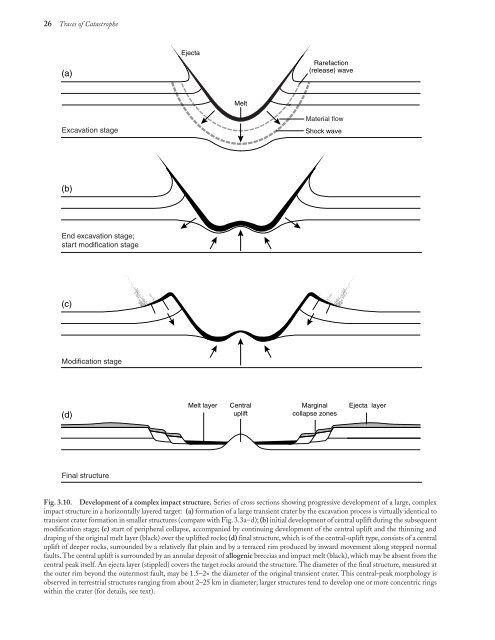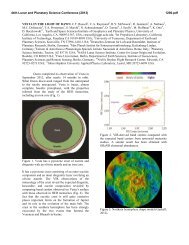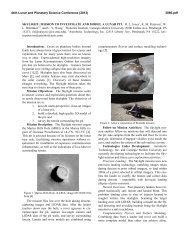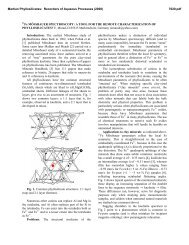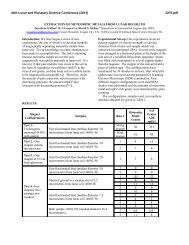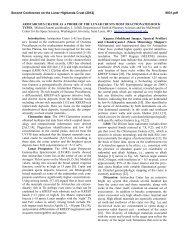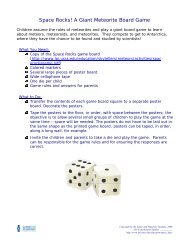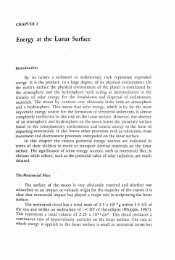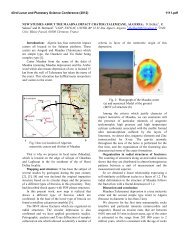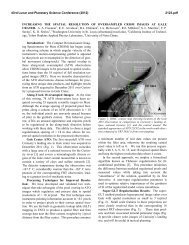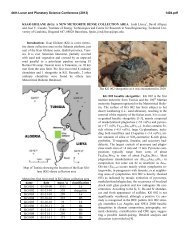26 Traces <strong>of</strong> Catastrophe Fig. 3.10. Development <strong>of</strong> a complex impact structure. Series <strong>of</strong> cross sections showing progressive development <strong>of</strong> a large, complex impact structure in a horizontally layered target: (a) formation <strong>of</strong> a large transient crater by the excavation process is virtually identical to transient crater formation in smaller structures (compare with Fig. 3.3a–d); (b) initial development <strong>of</strong> central uplift during the subsequent modification stage; (c) start <strong>of</strong> peripheral collapse, accompanied by continuing development <strong>of</strong> the central uplift <strong>and</strong> the thinning <strong>and</strong> draping <strong>of</strong> the original melt layer (black) over the uplifted rocks; (d) final structure, which is <strong>of</strong> the central-uplift type, consists <strong>of</strong> a central uplift <strong>of</strong> deeper rocks, surrounded by a relatively flat plain <strong>and</strong> by a terraced rim produced by inward movement along stepped normal faults. The central uplift is surrounded by an annular deposit <strong>of</strong> allogenic breccias <strong>and</strong> impact melt (black), which may be absent from the central peak itself. An ejecta layer (stippled) covers the target rocks around the structure. The diameter <strong>of</strong> the final structure, measured at the outer rim beyond the outermost fault, may be 1.5–2× the diameter <strong>of</strong> the original transient crater. This central-peak morphology is observed in terrestrial structures ranging from about 2–25 km in diameter; larger structures tend to develop one or more concentric rings within the crater (for details, see text).
ing basin structures (Grieve at al., 1981; Melosh, 1989, Chapter 8; Spudis, 1993). As the terms suggest, these structures are characterized by the initial development <strong>of</strong> a basin in the central peak <strong>and</strong> eventually by the complete conversion <strong>of</strong> the central peak area to a ring structure (Figs. 1.3, 3.9, <strong>and</strong> 3.11). These distinctions, <strong>and</strong> the transition diameters at which they occur, have been most clearly established on airless bodies like the Moon, where even large ancient structures have been well preserved (Figs. 3.6, 3.8, <strong>and</strong> 3.11) (e.g., Taylor, 1982, 1992; Melosh, 1989, pp. 131–135; Spudis, 1993). Classification <strong>of</strong> large terrestrial structures (e.g., papers in Schultz <strong>and</strong> Merrill, 1981; Spudis, 1993, pp. 24–41) is more difficult <strong>and</strong> uncertain, because the impact structures, especially their critical upper parts, tend to be removed by erosion or buried by later sediments. Furthermore, the critical diameters at which one form changes to another depend inversely on the planetary gravity, making it difficult to apply data from structures on other planets to terrestrial features. For example, the transition between simple <strong>and</strong> complex craters occurs at about 20 km diameter on the Moon but at only 2–4 km on Fig. 3.11. A lunar impact basin. This large impact structure (Schrödinger: D = 320 km) is located on the lunar farside near the Moon’s South Pole. Although ancient <strong>and</strong> highly degraded, it still preserves features distinctive <strong>of</strong> larger complex impact structures: a central uplift <strong>and</strong> terraced walls. However, in this large structure, the central uplift appears as an interior peak ring about 150 km in diameter (arrows), in sharp contrast to the simpler central peak formed in smaller complex structures. (<strong>Lunar</strong> Orbiter image LO-IV-8M.) <strong>Formation</strong> <strong>of</strong> <strong>Impact</strong> <strong>Craters</strong> 27 Earth. The subsequent transition between a central-peakbasin structure to a peak-ring structure occurs at about 150– 200 km on the Moon, but at only about 20–25 km on Earth. Despite the various difficulties, it has been possible to establish rough boundaries for different types <strong>of</strong> terrestrial complex structures (Grieve et al., 1981, p. 42, Fig. 2). These limits, <strong>and</strong> some typical examples, are: central-peak structures (D = 4–22 km) [Steinheim (Germany), Sierra Madera (Texas)]; central-peak-basin structures (D = 22–30 km) [Mistastin (Canada)]; peak-ring-basin structures (D = 30– 62 km) [West Clearwater (Canada); Fig. 1.3]. These values are only approximations, <strong>and</strong> they will almost certainly change as more structures are studied in detail <strong>and</strong> as the formation <strong>of</strong> complex craters is better understood. 3.2.3. Multiring Basins The largest planetary impact structures so far identified have diameters <strong>of</strong> a few hundred kilometers to more than 1000 km (e.g., papers in Schultz <strong>and</strong> Merrill, 1981; Melosh, 1989, Chapter 9; Spudis, 1993). In contrast to smaller impact structures, they appear as huge geological bulls-eyes, composed <strong>of</strong> multiple concentric uplifted rings <strong>and</strong> intervening down-faulted valleys (ring grabens) (Fig. 3.12). These features, designated multiring basins, are defined as structures that have two or more interior rings in addition to the outer rim <strong>of</strong> the structure. Multiring impact basins have been produced by the impact <strong>of</strong> projectiles tens to hundreds <strong>of</strong> kilometers in diameter, <strong>and</strong> they date mainly from an early period in the solar system (>3.9 Ga), when such large objects were more abundant <strong>and</strong> collisions were more frequent. The best multiring basins are best observed on planets with well-preserved ancient surfaces, such as the Moon, Mercury, parts <strong>of</strong> Mars, <strong>and</strong> some <strong>of</strong> the moons <strong>of</strong> Jupiter. Mare Orientale, on the Moon, with a diameter <strong>of</strong> at least 900 km, is one <strong>of</strong> the most prominent <strong>and</strong> best-known multiring basins (Fig. 3.12), but even larger features exist, such as the Valhalla Basin (D ~4000 km) on Jupiter’s icy moon Callisto. In addition, there are numerous large basins in the solar system that do not display a pronounced multiring structure, possibly because they have been deeply eroded since they formed. These include the Caloris Basin (Mercury; D = 1300 km), the Argyre Basin (Mars; D > 900 km) (Fig. 1.9), <strong>and</strong> the recently identified South Pole-Aitken Basin on the Moon (D ~2500 km). On the Moon, the transition to multiring basins occurs at diameters <strong>of</strong> about 400–600 km. Because the transition diameters for different crater forms vary inversely with planetary gravity, this observation implies that multiring basins should begin to form on Earth at crater diameters greater than about 100 km. Because the few terrestrial impact structures in this size range have been deeply eroded or buried (e.g., Fig. 1.4), it has not yet been possible to demonstrate clearly that any multiring basins exist on the Earth. The few possible c<strong>and</strong>idates (<strong>and</strong> their current estimated diameters) are Manicouagan (Canada, 100 km), Popigai (Russia, 100 km), Vredefort (South Africa, >200 km), Sudbury


